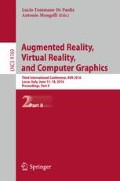Abstract
This paper presents the AMICA VR system, aiming at exploiting immersive visualization paradigms enabling visitors to be physically and emotionally involved in a virtual experience conceived for the dissemination of the activities related to craftsmanship of printmaking. The developed platform aims at spreading a better knowledge about printmaking by appropriately using Interactive Digital Storytelling and Immersive Virtual Environments, exploiting their features in terms of presence, immersion, interaction and multi-modality.
Access this chapter
Tax calculation will be finalised at checkout
Purchases are for personal use only
Notes
References
Schank, R.C., Berman, T.R., Macpherson, K.A.: Learning by doing. Instr. Des. Theor. Models: New Paradig. Instr. Theor. 2, 161–181 (1999)
Carrozzino, M., Bruno, N., Bergamasco, M.: Designing interaction metaphors for Web3D cultural dissemination. J. Cult. Herit. 14(2), 146–155 (2013)
Ruffaldi, E., Evangelista, C., Neri, V., Carrozzino, M., Bergamasco, M.: Design of information landscapes for cultural heritage content. In: Proceedings of the 3rd International Conference on Digital Interactive Media in Entertainment and Arts, pp. 113–119. ACM, September 2008
Skills project, CORDIS EU. http://cordis.europa.eu/project/rcn/103956_en.html
Carrozzino, M., et al.: AMICA - Virtual Reality as a Tool for Learning and Communicating the Craftsmanship of Engraving (2015)
Zoran, A., Buechley, L.: Hybrid reassemblage: an exploration of craft, digital fabrication and artifact uniqueness. Leonardo 46(1), 4–10 (2013)
Driscoll, M.P., Driscoll, M.P.: Psychology of learning for instruction (2005)
Johnson, W.Lewis, et al.: Integrating pedagogical agents into virtual environments. Presence: Teleoperators Virtual Environ. 7(6), 523–546 (1998)
Mitchenson, D.: Safeguarding intangible cultural heritage by creating meaningful transmission experiences. Int. J. Herit. Digit. Era 4(1), 57–70 (2015)
Forte, M.: Virtual worlds, virtual heritage and immersive reality: the case of the Daming Palace at Xi’an, China, chap. 26 (2013)
Carrozzino, M., et al.: Virtually preserving the intangible heritage of artistic handicraft. J. Cult. Herit. 12(1), 82–87 (2011)
Lu, P., et al.: Image-based non-photorealistic rendering for realtime virtual sculpting. Multimed. Tools Appl. 74(21), 9697–9714 (2015)
Dagnino, F., et al.: Serious Games design: reflections from an experience in the field of Intangible Cultural Heritage education. In: The International Scientific Conference eLearning and Software for Education, vol. 2. “Carol I” National Defence University (2015)
Zhang, X.-M.: Computer simulation of the interaction on pigment and paper in virtual painting. In: Proceedings of the 2014 7th International Conference on Intelligent Computation Technology and Automation. IEEE Computer Society (2014)
Mäkilä, T., et al.: The Futuristic History project: recreating history with augmented reality solutions. In: Proceedings of NODEM, pp. 165–170 (2013)
Cheng, Z., et al.: Capturing human motion in natural environments. Procedia Manuf. 3, 3828–3835 (2015)
Sarbolandi, H., Lefloch, D., Kolb, A.: Kinect range sensing: structured-light versus time-of-flight Kinect. Comput. Vis. Image Underst. 139, 1–20 (2015)
Tecchia, F., et al.: I’m in VR!: using your own hands in a fully immersive MR system. In: Proceedings of the 20th ACM Symposium on Virtual Reality Software and Technology, pp. 73–76. ACM, November 2014
Chen, Y., et al.: Fast capture of personalized avatar using two Kinects. J. Manuf. Syst. 33(1), 233–240 (2014)
Rafighi, A., Seifi, S., Meruvia-Pastor, O.: Automatic and adaptable registration of live RGBD video streams. In: Proceedings of the 8th ACM SIGGRAPH Conference on Motion in Games. ACM (2015)
Zhang, J., et al.: RGB-D-Based Action Recognition Datasets: A Survey (2016). arXiv preprint arXiv:1601.05511
Ni, B., Wang, G., Moulin, P.: RGBD-HuDaAct: A Color-Depth Video Database for Human Daily Activity Recognition. Consumer Depth Cameras for Computer Vision, pp. 193–208. Springer, London (2013)
Zhao, S., et al.: Strategy for dynamic 3D depth data matching towards robust action retrieval. Neurocomputing 151, 533–543 (2015)
Salti, S., Tombari, F., Di Stefano, L.: SHOT: unique signatures of histograms for surface and texture description. Comput. Vis. Image Underst. 125, 251–264 (2014)
Normand, J.M., Spanlang, B., Tecchia, F., Carrozzino, M., Swapp, D., Slater, M.: Full body acting rehearsal in a networked virtual environment—a case study. Presence: Teleoperators Virtual Environ. 21(2), 229–243 (2012)
Shafer, D.M., Carbonara, C.P., Popova, L.: Spatial presence and perceived reality as predictors of motion-based video game enjoyment. Presence: Teleoperators Virtual Environ. 20(6), 591–619 (2011)
Brondi, R., et al.: Immersive Technologies and Natural Interaction to Improve Serious Games Engagement. Games and Learning Alliance. Springer International Publishing, Switzerland (2015)
Roupé, M., Bosch-Sijtsema, P., Johansson, M.: Interactive navigation interface for virtual reality using the human body. Comput. Environ. Urban Syst. 43, 42–50 (2014)
Tecchia, F., et al.: A flexible framework for wide spectrum VR development. Presence 19(4), 302–312 (2010)
Spanlang, B.: HALCA a library for presence research. Rapport technique, Event Lab, Barcelona, Spain (2009)
Tanca, C.A.: Progettazione e sviluppo di un modulo software per la creazione e manipolazione di animazioni facciali realistiche in Virtual Humans conversazionali. Master Degree Thesis, University of Pisa (2015)
Huang, W., Alem, L., Tecchia, F.: HandsIn3D: supporting remote guidance with immersive virtual environments. In: Winckler, M. (ed.) INTERACT 2013, Part I. LNCS, vol. 8117, pp. 70–77. Springer, Heidelberg (2013)
Acknowledgements
We warmly thank 2RC Gallery for their invaluable partnership and, in particular, Valter and Simona Rossi, and their collaborators Nicola Salotti, Laura Peres, Elisa Favilli, Irene Puglisi, Elena Mantovani, Laura Fonsa. We also thank Emily Manfredi for contributing to the storytelling text. The AMICA project is funded by Fondazione Telecom Italia under the “Beni Invisibili” financing program. The study of the related work and the setup of the test methodology have been carried out in the context of the EU eHERITAGE project.
Author information
Authors and Affiliations
Corresponding author
Editor information
Editors and Affiliations
Rights and permissions
Copyright information
© 2016 Springer International Publishing Switzerland
About this paper
Cite this paper
Carrozzino, M. et al. (2016). An Immersive VR Experience to Learn the Craft of Printmaking. In: De Paolis, L., Mongelli, A. (eds) Augmented Reality, Virtual Reality, and Computer Graphics. AVR 2016. Lecture Notes in Computer Science(), vol 9769. Springer, Cham. https://doi.org/10.1007/978-3-319-40651-0_30
Download citation
DOI: https://doi.org/10.1007/978-3-319-40651-0_30
Published:
Publisher Name: Springer, Cham
Print ISBN: 978-3-319-40650-3
Online ISBN: 978-3-319-40651-0
eBook Packages: Computer ScienceComputer Science (R0)

